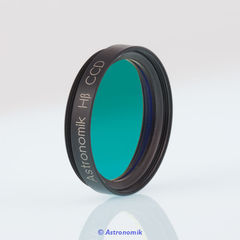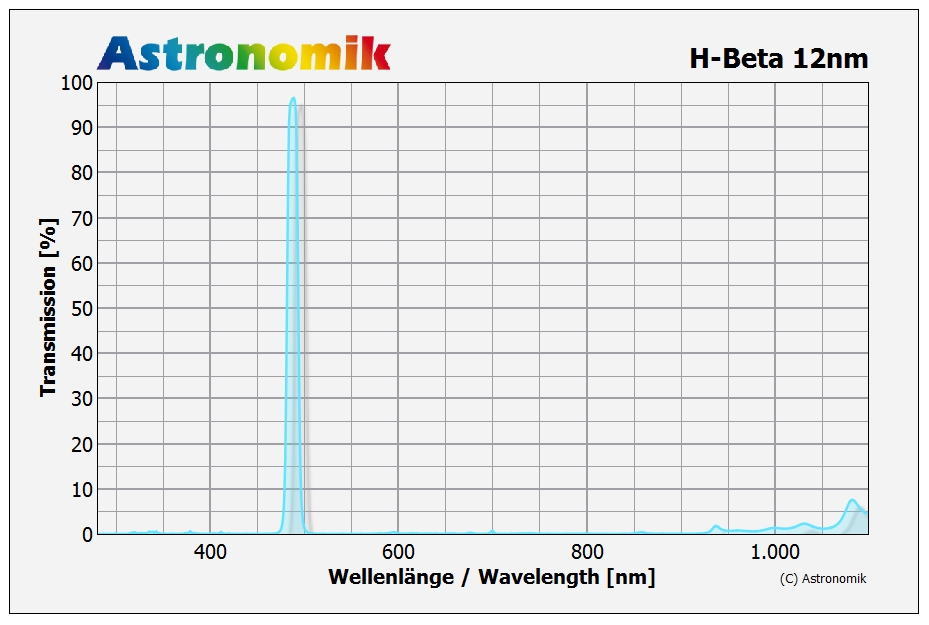- Astronomik Lunar calendar for 2024
The Astronomik calendar of the Lunar phases in 2024 is ready.
- Chistmastime and New Year 2023-2024
We wish you a merry Chirstmastime and a happy and healthy 2024...
- Astronomik Lunar calendar for 2023
The Astronomik calendar of the Lunar phases in 2023 is ready.
- Chistmastime and New Year 2022-2023
We wish you a merry Chirstmastime and a happy and healthy 2023...
- Shipping methods
Shipping as registred good shipment is no longer available
- How to observe planetary nebulae
A very nice introduction to observing planetary nebulas written by Owen Brazell
- Astronomik Lunar calendar for 2022
The Astronomik calendar of the Lunar phases in 2022 is ready.
- Website down
Our website was down on dec 20st...
- H-alpha imaging with a unmodified EOS R
Imaging with an unmodified camera using a H-alpha filter
- Astronomik Lunar calendar for 2021
The Astronomik calendar of the Lunar phases in 2021 is ready.
Astronomik H-beta-CCD 12nm Filter

Click the image for full resolution
The Astronomik H-beta filter is a narrow band emission-line filter for CCD photography. The filter lets the H-beta light of emission nebulae pass and blocks nearly the whole remainder of the spectrum where the CCD is sensitive.The full width at half-maximum (FWHM) of 12nm is optimized for the use with common CCD cameras and allows the use of very fast optics. It should be noted that the filter has a transmission of up to 99%.
Another advantage of the 12nm filters is the better availability of guiding stars for cameras with a built-in-autoguider (SBIG). If you use a very strong filter like our H-alpha 6nm filter you often won’t find a usable guidestar.
Together with the other three Astronomik emission-line filters you can do great color images even from very light polluted places!
The filter has a built-in IR-blocker up to 1150nm. You don’t need an additional IR-blocker with this filter.
Main use
The Astronomik H-beta-CCD increases the contrast between objects, in this case between the H-beta emission line and the skyglow background. Our Astronomik H-beta-CCD completely suppresses the emission lines of artificial lighting (mercury (Hg) and sodium (Na)) and skyglow. The optimal aperture ratio for this filter is 1:3.5 to 1:6. The range of application extends from 1:2.8 to 1:15. Transmission losses and chromatic distortions, which arise with other filters, only occur with Astronomik filters when extremely bright aperture ratios of 1:2 and more come into play.
Other uses
- When using the Astronomik H-beta CCD filter together with the H-alpha CCD, OIII-CCD and the SII-CCD filters you can obtain three-color images of emission line objects (gas nebulae) from locations with very strong light pollution. To do so, you would take an image in three different wavelengths, select each one as a color-channel in Photoshop and paste them together as a color image.
- When using the Astronomik H-beta filter together with the H-alpha-CCD you can create charts of the ionization energy in nebulas by creating an image from the ratio of H-alpha vs. H-beta.
- If you plan to create color images from emission line data, our CLS-CCD filter is a great choice for the Luminance channel
- The H-beta-CCD is also great for visual observation. If you plan to get filters for visual observation and for astrophotography get the CCD filter: You may use this filter visual as well as in front of you camera. The built-in IR-blocker doesn’t disturb visual observation but you need an additional IR-blocker if you want to use the visual filer with your camera.
more information about the photographic Astronomik filters
How to read the chart
The major emission lines of artifical light pollution:
| Hg 435,8nm | Hg 546,1nm | Hg 577,0nm | Hg 578,1nm |
| Na 589,0nm | Na 589,6nm | Na 615,4nm | Na 616,1nm |
The major emission lines of nebulas:
H-β 486,1nm | OIII 495,9nm | OIII 500,7nm | H-α 656,3nm
- The horizontal axis is the Wavelength in Nanometers (nm). 400nm is deep blue, at 520nm the human eye senses green and at 600nm red. At 656nm is the famous "H-Alpha" emission line of hydrogen.
- The transmission in % is plotted on the vertical axis.
- The red line shows the transmission of the filter.
- Visual filters: The grey line in the background shows the relative sensitivity of the human eye at night. The maximum is at ~510nm and drops to longer and shorter wavelengths. You can easily see, that you can´t see anything of the H-alpha line at night (even if you can during daylight!) The sensitivity at 656nm is 0% at night!
- Photographic filters: The grey line in the background shows the sensitivity of a typical CCD sensor.
- The most important artifical emission lines are shown in orange. The artifical light pollution is dominated by see mercury (Hg) and sodium (Na), which are used in nearly all streetlights.
- The most important emission lines from nebulas are shown in green. The most important lines are from ionized Hydrogen (H-alpha and H-beta) and double ionized oyxgen (OIII).
The major emission lines of artifical light pollution:
| Hg 435,8nm | Hg 546,1nm | Hg 577,0nm | Hg 578,1nm |
| Na 589,0nm | Na 589,6nm | Na 615,4nm | Na 616,1nm |
The major emission lines of nebulas:
H-β 486,1nm | OIII 495,9nm | OIII 500,7nm | H-α 656,3nm
Suitability
- Visual observation (dark skies): Very good, but only suitable for a few objects
- Visual observation (urban skies): Unsuitable
- Film photography: It depends, very long exposure time
- CCD photography: Very good, but only suitable for a few objects
- DSLR photography (original): Very good, but only suitable for a few objects
- DSLR photography (astro modified): Very good, but only suitable for a few objects
- DSLR photography (MC modified): Very good, but only suitable for a few objects
- Webcam / Video (Planets): Unsuitable
- Webcam / Video (Deep Sky): Unsuitable
Technical Data
- 98% transmission at 486nm (H-beta)
- full width at half maximum 12nm
- complete blocking from 350nm to 470nm and 500nm to 1100nm
- Parfocal with other Astronomik filters
- Glass thickness: 1mm
- Completely resistant against high humidity, scratches and aging effects
- Diffraction limited, the filter will not reduce the optical performance of your telescope!
- Astronomik filters are delivered in a high-quality, long lasting, filter box
- Since 2008 we do ship filters with a completely new design. Any kind of halo or strange reflection is a matter of past
The filter is available in the following sizes
- This filter is not in production anymore. The whole stpock has been sold and the Astronomik H-beta 12nm CCD no longer available! (January 2018)
H-beta 12nm CCD-Filter
There are no products matching the selection.

 Deutsch
Deutsch English
English